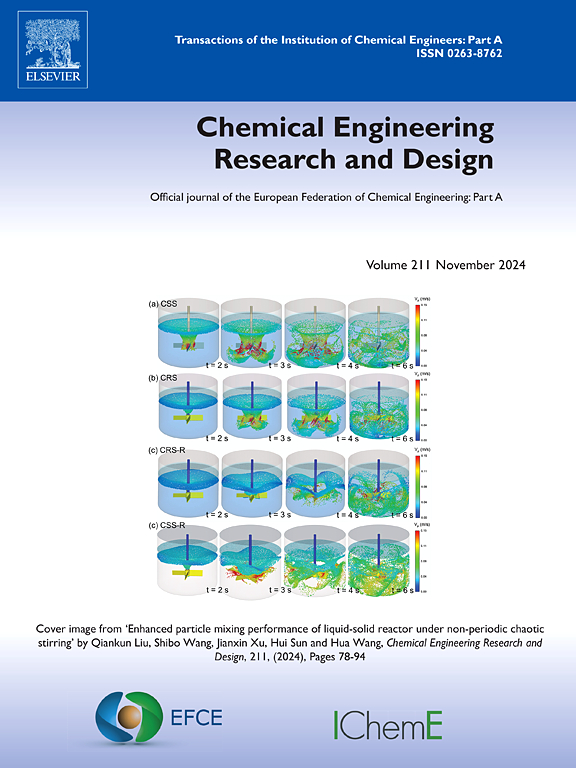纯断裂离散种群平衡方程的解析解及其在核辨识中的应用
IF 3.7
3区 工程技术
Q2 ENGINEERING, CHEMICAL
引用次数: 0
摘要
颗粒破碎是制药,采矿和材料加工等行业的关键过程,其中控制粒度分布对于优化产品性能至关重要。破碎过程中粒径的演变通常用种群平衡方程(PBE)和破碎的力学和经验模型来描述。虽然通常使用数值方法来求解PBE,但它们计算量大,容易产生不稳定性,而且现有的解析解通常仅限于特定的核形式。在这项工作中,我们提出了一个离散PBEs的解析解,适用于线性和非线性破碎核。我们的方法利用Sylvester的展开来求解PBE并计算磨矿矩阵的特征向量,从而实现对粒度分布的广义、高效和准确的预测。针对Ziff和McGrady的特定核的分析解决方案的验证证明了非常好的一致性,而IKA Magic Lab®和Quadro Ytron®湿磨工艺的实验数据证实了该模型在不同操作条件下的核识别能力、鲁棒性和多功能性。该模型通过引入Austin等人的破碎核,有效地捕捉了磨矿参数对颗粒破碎的影响。这种分析解决方案为理解和优化跨不同系统的断裂过程提供了一个健壮的框架。它对各种核的适应性和最小的计算复杂度使其成为研究人员和工艺开发工程师的宝贵工具。通过这项工作获得的见解可以指导最佳颗粒处理技术的设计,其潜在应用范围不仅限于研磨,还包括研磨和其他粉碎系统。本文章由计算机程序翻译,如有差异,请以英文原文为准。
Analytical solution to the discretized population balance equation for pure breakage with application to kernel identification
Particle breakage is a key process in industries such as pharmaceuticals, mining, and materials processing, where controlling particle size distribution is critical for optimizing product properties. The evolution of particle size during breakage is often described by the population balance equation (PBE) with mechanistic and empirical models for breakage. While numerical methods are commonly used to solve PBE, they are computationally intensive and prone to instabilities, and existing analytical solutions are typically limited to specific kernel forms. In this work, we present an analytical solution for discretized PBEs applicable to both linear and nonlinear breakage kernels. Our method utilizes Sylvester’s expansion to solve the PBE and compute eigenvectors of the milling matrix, enabling generalized, efficient, and accurate predictions of particle size distributions. Verification against Ziff and McGrady’s analytical solution for specific kernels demonstrated excellent agreement, while experimental data from IKA Magic Lab® and Quadro Ytron® wet milling processes confirmed the model’s kernel identification capabilities, robustness, and versatility across different operating conditions. By incorporating Austin et al.'s breakage kernels, the model effectively captures the influence of milling parameters on particle fragmentation. This analytical solution offers a robust framework for understanding and optimizing breakage processes across diverse systems. Its adaptability to various kernels and minimal computational complexity makes it a valuable tool for both researchers and process development engineers. The insights gained through this work can guide the design of optimal particle processing technologies, with potential applications extending beyond milling to include grinding and other comminution systems.
求助全文
通过发布文献求助,成功后即可免费获取论文全文。
去求助
来源期刊

Chemical Engineering Research & Design
工程技术-工程:化工
CiteScore
6.10
自引率
7.70%
发文量
623
审稿时长
42 days
期刊介绍:
ChERD aims to be the principal international journal for publication of high quality, original papers in chemical engineering.
Papers showing how research results can be used in chemical engineering design, and accounts of experimental or theoretical research work bringing new perspectives to established principles, highlighting unsolved problems or indicating directions for future research, are particularly welcome. Contributions that deal with new developments in plant or processes and that can be given quantitative expression are encouraged. The journal is especially interested in papers that extend the boundaries of traditional chemical engineering.
 求助内容:
求助内容: 应助结果提醒方式:
应助结果提醒方式:


